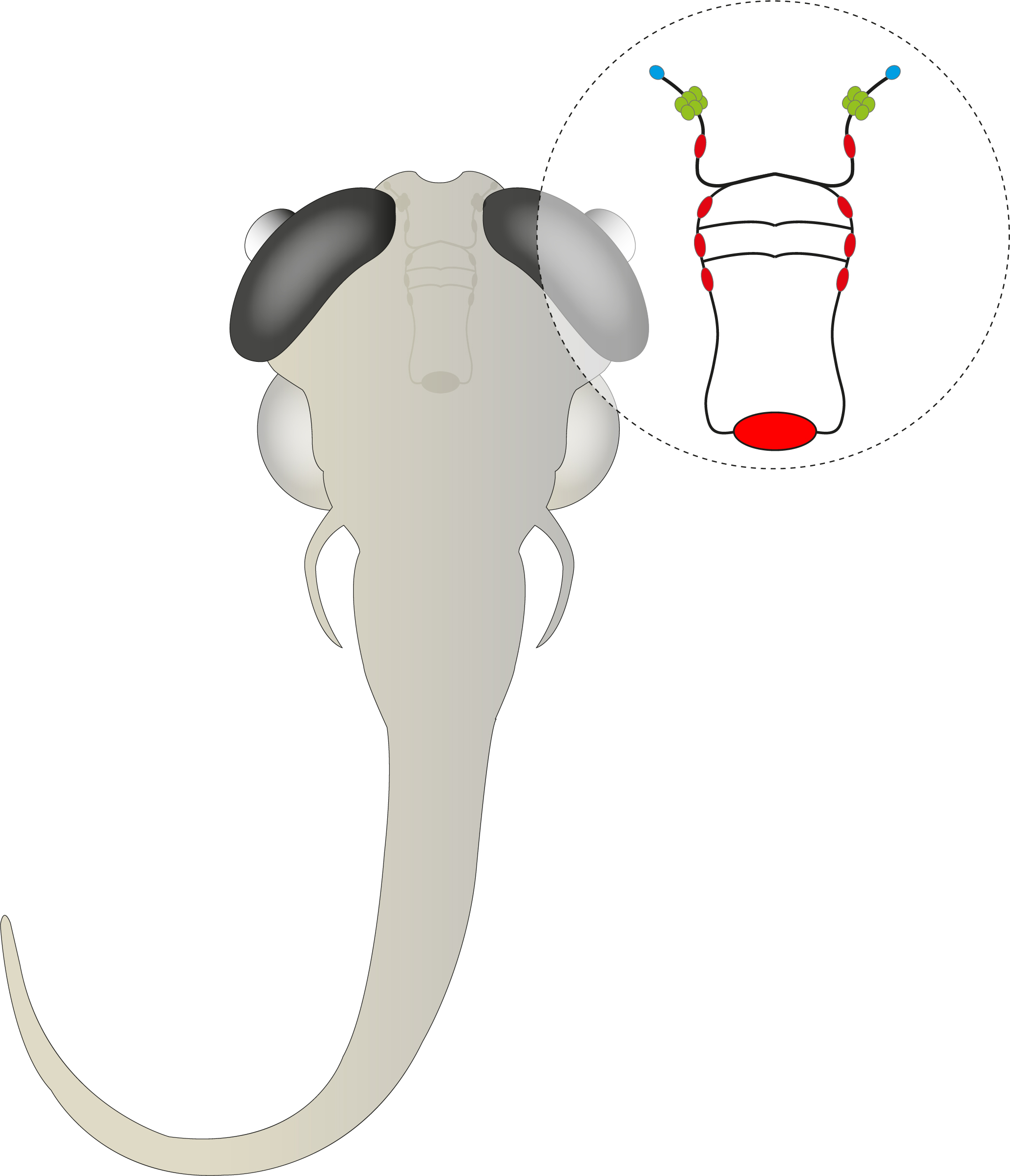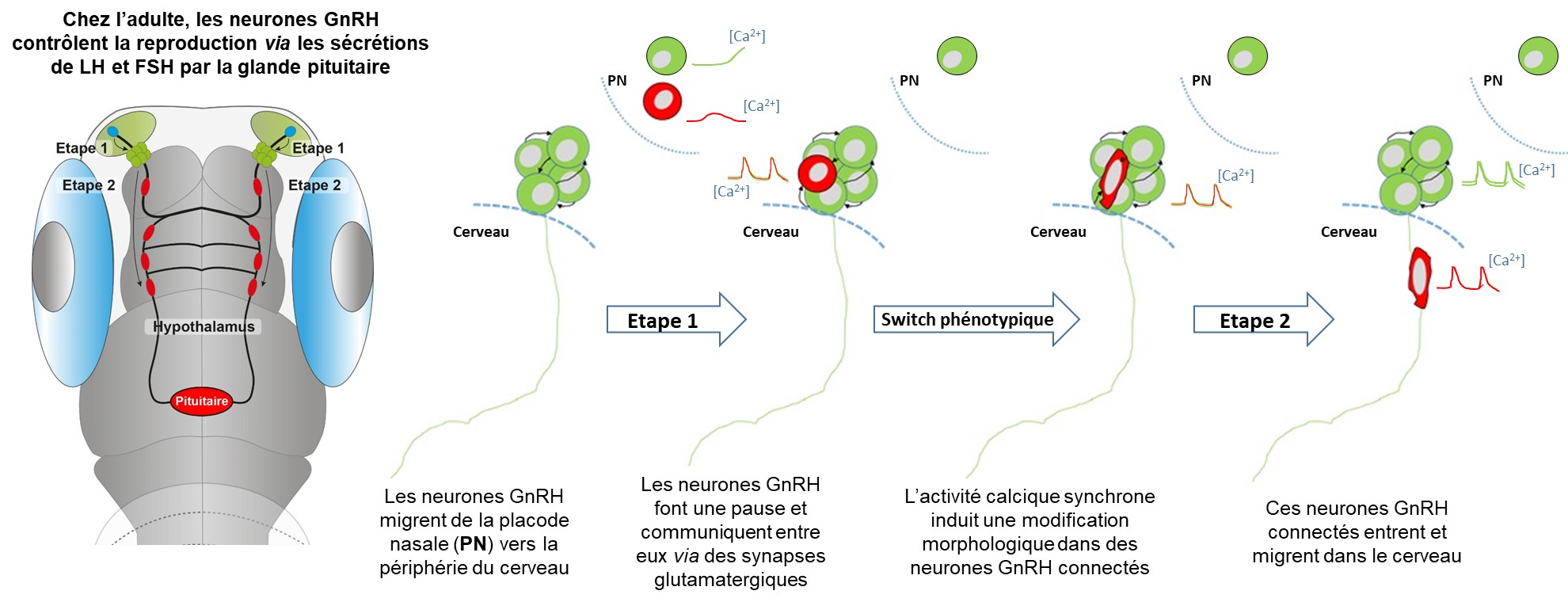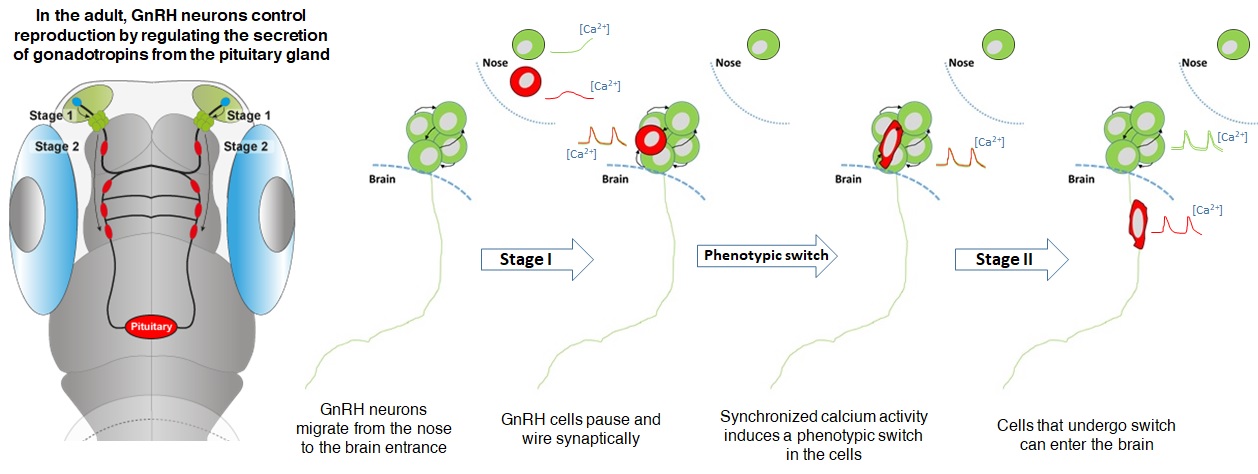
MIGRATION DES NEURONES GNRH: QUAND COMMUNIQUER PERMET DE PRÉSERVER L’ESPÈCE
Au cours de l’évolution, la communication entre des individus a été essentielle pour leur adaptation à un nouvel environnement et la préservation de l’espèce. Cette étude, publiée dans la revue Science Advances, montre que c’est aussi le cas pour la migration de la petite population de neurones GnRH (environ deux mille neurones GnRH chez l’Homme et moins d’une centaine chez le poisson) qui contrôle la reproduction chez les vertébrés.
Chez l’Homme et tous les vertébrés, la survie des espèces dépend d’une étape essentielle du développement embryonnaire : la migration des neurones synthétisant et sécrétant la GnRH (gonadolibérine) de la placode nasale vers le cerveau où ils rejoignent l’hypothalamus pour contrôler la libération des gonadotrophines hypophysaires (LH et FSH) et ainsi la reproduction. Ces travaux apportent une vision nouvelle sur cette migration neuronale en l’étudiant dans un modèle de vertébrés (larve de poisson zèbre) par transgénèse et imagerie longitudinale multiphotonique.
Les chercheurs montrent que ces neurones GnRH font une pause à la frontière entre la placode nasale et le cerveau où ils se mettent en place et fonctionnent comme un réseau inter-hémisphère qui est isolé "synaptiquement" du reste du cerveau. Seuls les neurones qui intègrent ce réseau et qui sont capables de communiquer avec leurs congénères via le neurotransmetteur glutamate, pourront finalement changer de morphologie. Ce changement leur permettra ensuite de traverser la barrière et de continuer leur chemin migratoire vers leur destination finale et fonctionnelle dans l’hypothalamus, une région profonde du cerveau. Ces communications synaptiques entre les neurones GnRH sont tellement robustes à ce stade du développement du cerveau qu’une ablation partielle des neurones à l’interface placode-cerveau ne perturbe pas la migration des neurones GnRH dans le cerveau.
Cette étude amène à un nouveau concept de la migration des neurones GnRH dans lequel les neurones GnRH fonctionnent plus comme une population connectée que comme des unités individuelles. Elle pourrait aussi apporter un éclairage nouveau sur l’origine de pathologies de la reproduction et d’infertilité chez l’Homme, comme celles observées chez les patients souffrant du syndrome de Kallmann et ouvrir la voie à de nouveaux tests génétiques.
 Illustration du mode de migration en réseau connecté des neurones GnRH qui contrôlent la reproduction chez les vertébrés
Illustration du mode de migration en réseau connecté des neurones GnRH qui contrôlent la reproduction chez les vertébrés
et la préservation de l’espèce (modèle : larve de poisson zèbre)
Pour en savoir plus
Synaptic communication mediates the assembly of a self-organizing circuit that controls reproduction.
Golan M, Boulanger-Weill J, Pinot A, Fontanaud P, Faucherre A, Gajbhiye DS, Hollander-Cohen L, Fiordelisio-Coll T, Martin AO, Mollard P. Sci Adv. 2021 Feb 19;7,eabc8475. doi: 10.1126/sciadv.abc8475. Print 2021 Feb.
......................................................................................................................................................................................................
MIGRATION OF GNRH NEURONS: WHEN COMMUNICATION HELPS PRESERVE THE SPECIES
During the course of evolution, communication between individuals has been essential for their adaptation to a new environment and the preservation of the species. This study, published in the journal Science Advances, shows that this is also the case for the migration of the small population of Gonadotropin-Releasing Hormone (GnRH) neurons (around 2,000 cells in humans and ~100 in zebrafish) which controls reproduction in all vertebrates.
In humans and all vertebrates, the survival of the species depends on an essential stage of embryonic development: the migration of neurons synthesizing and secreting GnRH from the nasal placode to the brain where they join the hypothalamus to control the release of pituitary gonadotropins (LH and FSH) and thus reproduction. This work provides a new view of this migration by using transgenic zebrafish larvae as a vertebrate model and longitudinal in vivo multiphoton imaging.
The researchers show that these neurons pause at the border between the nasal placode and the brain where they form an inter-hemisphere network that is synaptically isolated from the rest of the brain. Only the neurons which integrate into this network and which are able to communicate with neighboring GnRH cells using the neurotransmitter glutamate, will be able to finally change morphology. This change will then allow them to cross the barrier and continue their migratory journey to their final and functional destination in the hypothalamus, deep inside the brain. The synaptic communication between GnRH neurons is so robust at this stage of brain development, that partial ablation of neurons at the placode-brain interface does not disrupt the migration of GnRH neurons from the other hemisphere.
This study reveals a new concept of GnRH neuron migration in which GnRH neurons function more as a connected population than as individual units. It could also shed new light on the origin of reproductive pathologies and infertility in humans, such as those observed in patients with Kallmann syndrome and pave the way for new genetic screens.
Illustration of the mode of migration in a connected network of GnRH neurons
which control reproduction in vertebrates and preservation of the species (model: zebrafish larva)
To know more
Synaptic communication mediates the assembly of a self-organizing circuit that controls reproduction.
Golan M, Boulanger-Weill J, Pinot A, Fontanaud P, Faucherre A, Gajbhiye DS, Hollander-Cohen L, Fiordelisio-Coll T, Martin AO, Mollard P. Sci Adv. 2021 Feb 19;7,eabc8475. doi: 10.1126/sciadv.abc8475. Print 2021 Feb.







